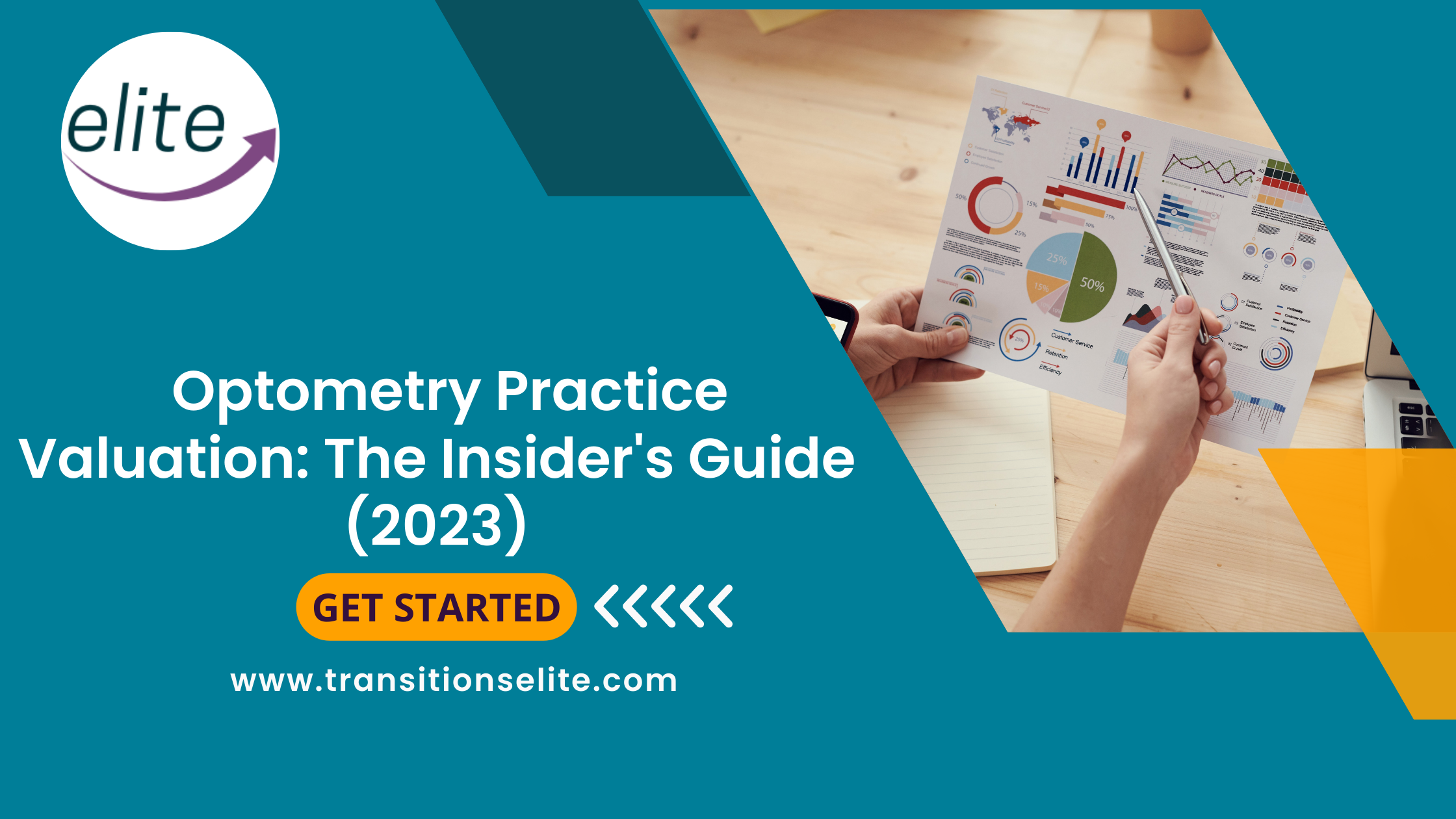Optometry Practice Valuation: The Insider’s Guide(2024)
What is Optometry Practice Valuation?
Optometry practice valuation is the process of determining the fair market value of an optometry practice. It considers factors such as location, patient base, revenue, expenses, and assets. Experts use the income, market, and asset-based approaches to value optometry practices.
Don’t miss out on this opportunity to have your practice valued by the experts. This can be a helpful exercise to understand where your optometry practice stands and how to grow it to ensure it can yield great returns in the near future.
Steps to Accurately Value Your Optometry Practice
Learn the steps to accurately value your optometry practice in 2024. From factors that impact value to tried and tested valuation methodologies used by experts, this guide covers everything you need to know to make informed decisions when buying or selling an optometry practice
There’s a lot of discussion about valuing medical practices these days, and while it may seem complicated, appraising an optometry practice isn’t rocket science. And it doesn’t have to cost a fortune, either! We’ve been helping ODs sell their beloved asset for maximum returns for many years, and in this guide, we’ll be exploring the best ways to know how much your optometry practice is worth.
Optometry Practice Valuation: A Few Things You Need To Know
Your Options: DIY Or Hire An Expert
The first thing you should know is that there are two ways to go about this:
Hire a professional who specializes in helping practice owners sell their practices. This option requires less time and effort, but you’ll need to pay for the service rendered. However, the payoff can be significant. If you have any questions regarding the valuation of your optometry practice, one of our experts will be glad to help – get in touch here.
Do it yourself. Seemingly the cheaper route, but the downside is that if you get it wrong, your practice could be worth less than you think, and you could lose out on a sale. If you don’t have time, or if you’re not comfortable with doing it yourself, then consider the first option.
Don’t Rely On Valuation Based On Multiples (Or Rule Of Thumb)
For example, you may have heard that optometry practices are worth 1.5 to 2 times EBITDA (earnings before interest, taxes, depreciation, and amortization).
The last thing you want to do is base your practice value on multiples. The reason is that there are just too many variables that go into the valuation of a business.
Consequently, if you base your valuation on multiples, you could significantly undervalue your practice or overvalue it by using a national average instead of what’s appropriate for your market.
Understanding the Key Factors in Optometry Practice Valuation
Think of it like this:
Your practice is a product just like any other business; to sell it, you need to understand what makes it desirable. If you’re not sure, consider these factors:
Location. Where is your practice located? Is it in an area with high foot traffic? Are there other businesses in the area that complement or compete with yours? What about access to roads and parking spaces? These things determine how much people are willing to pay for a business in any area. For example, an office in a high-traffic area with plenty of foot traffic may be worth more than an office in a less desirable location — even if both offer similar services.
Average Revenue Per Patient. This number estimates how much money each patient generates for the practice.
Growth potential. Another factor to consider when selling your practice is its growth potential — how much more could it earn by adding new services or locations?
Technology And Equipment. A practice with high-end equipment may be more appealing to buyers.
Leases and other contracts. Some leases are transferable, while others are not. In the case of the latter, potential buyers would use it during negotiations to beat down the price of your practice.
Specialization. It is common for specialized practices to command higher prices because they have fewer competitors and appeal to a more niche audience than general practices.
Other factors that impact value:
- Liens against the practice or accounts receivable;
- The debt burden on the practice;
- The general state of the economy;
- Practice’s reputation;
- A legal case against the practice;
- Quality of key staff (employees); and,
- Size/age of the practice.
Methods Used In Optometry Practice Valuation
The method you choose will depend on the level of detail you require, as well as the time and resources available to you.
The three main methods used include:
Market-comparison method
This approach uses actual sales prices from other optometrists practices as the basis for estimating the value of yours.
Pro: The advantage of this approach is that it provides an accurate estimate based on recent transactions in your area.
Con: The disadvantage is that it depends on the accuracy of the information you get from other practice sellers, which might be difficult or inaccurate. And even though you have actual sales prices from other practitioners’ practices, they may not be relevant to yours because the buyers may have been motivated by unique circumstances that may not apply to your situation.
Bottomline: This approach doesn’t represent what your practice might be worth, but it provides insight into what kind of price buyers were willing to pay for similar practices like yours. It is a good starting place, especially if you are privy to the transaction details of the comparable practice(s) that sold.
Income approach
This method involves valuing an eyecare practice based on historical earnings it generates.
Earnings capitalization method: This method involves estimating the practice’s future earnings and capitalizing those earnings at a rate that reflects the level of risk associated with the practice.
Here’s the equation:
Value Of Optometry Practice = Adjusted Earnings/Capitalization Rate.
Discounted Cash Flow: This method uses historical financial data to project future cash flows from the practice. It then discounts these projected cash flows back to their present value using an appropriate discount rate.
The equation below shows how:
Value Of Optometry Practice = Present Value of Future Cash Flows/Discount Rate.
Pro: The income approach attempts to accurately measure a key aspect of an optometry clinic/hospital’s worth which potential buyers are keen on: cash flow.
Con: Value depends heavily on assumptions and projections. And any slight mistake in assumptions can greatly impact the outcome.
Asset-based method
This method involves evaluating all assets (tangible and intangible) owned by the practice, such as equipment, real estate, and “goodwill,” to determine the practice’s fair market value.
Goodwill: A significant portion of the value of an optometry practice is tied to goodwill. Goodwill is the value a company receives due to its reputation and customer loyalty. It is an intangible asset calculated based on several factors, including trademarks, patents, copyrights, franchise rights, brand recognition, and client retention rate.
The formula for calculating goodwill:
Goodwill = Purchase price of the target practice – (fair market value of assets – fair market value of liabilities).
Pro: The asset-based method is simple because it is based on the value of the assets owned by the company and does not require forecasting.
Con: This method fails to consider prospective future earnings.
Summary: The value of an optometry practice is derived from the sum of its assets.
Finally
When buying or selling an optometry practice, it’s important to get an accurate valuation. This information will help you ensure that you are getting a fair price for your business and that you can negotiate the best terms possible when selling it.
Want To Know What Your Optometry Practice Is Worth? We Can Help
We will value your practice appropriately, and you will know what steps are needed to take to capitalize on this evaluation. Plus, we can help you with the entire process, walk you through your options, and provide expert insights.
Fill out the short form below to get started.

Melani Seymour is a force of nature in entrepreneurial boots – a veterinary thought leader with a relentless drive to help practice owners unlock what’s next.
As the co-founder of the Owner Exchange, Transitions Elite and DVM Elite, Melani has spent over 15 years helping thousands of veterinary owners find their next big idea and in every case reimagine what’s possible for them personally and professionally – one smart decision at a time. Melani blends a background in psychology with deep industry insights to bring clarity, empathy, and practical guidance to every conversation. With zero tolerance for fluff her mission is simple: to elevate the quality of life for veterinary practice owners – and reshape the future of independent veterinary medicine.











